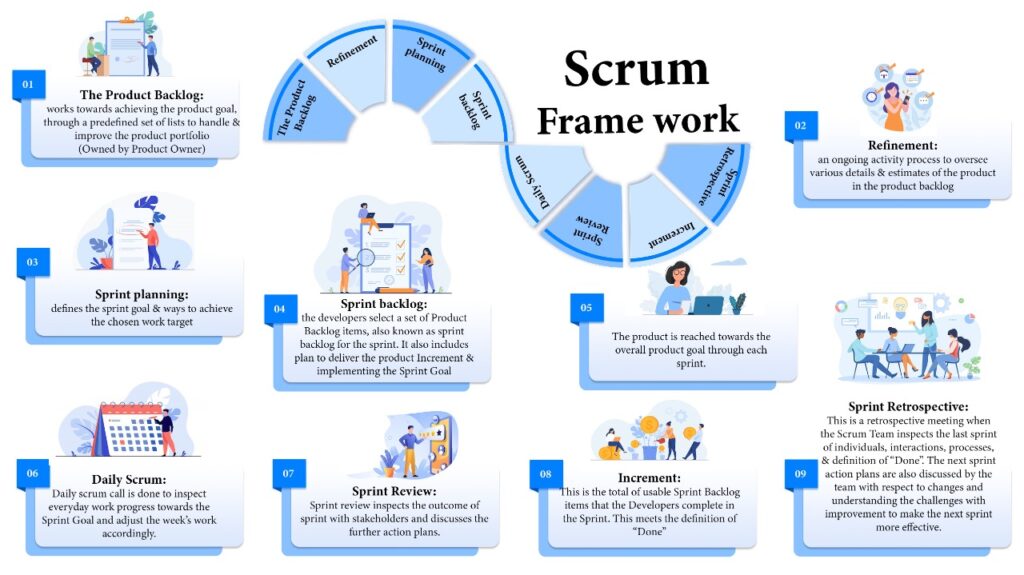
If you are a professional, many of you by now may know what scrum is! And, even if you don’t – have you heard of how a rugby team performs? Much to our surprise, the high-end framework, by default, have derived its name from Rugby – a game that has implemented high-performing cross-functional teams with the formation of the scrum.
At present, the use of scrum has gained wide momentum in all IT & Non-IT organizations owing to its application to all kinds of teamwork. However, professionals opting for a certified scrum master course have come across a huge wave of opportunities ahead of their agile career. The opportunities are both within or outside their organization.
If you are a minting Scrum Master, you should be able to comprehend the definition of scrum frameworks and the tools used within your scrum team.
But before we head into details, you must know what scrum is.
What is Scrum?
Scrum is a framework, which enables teams to work together with a lightweight yet demonstrative set of principles, values, & practices to deliver products and services within a period. Scrum promotes teamwork and encourages the team to learn through their experiences, mistakes, & learnings. This can be done while you are working on a project and hence, can be put to correction over time.
By implementing scrum, you can expose your teams to:
- Quick feedbacks
- Track their daily work and understand the backlog
- Transparency & Innovation at work
- Inspection & Improvement with project work
- Adapting to a new work culture
- Smooth execution and handling of customers
- Smooth work delivery from ideation to implementation
The Scrum Guide describes scrum as “a lightweight framework that helps people, teams, and organizations generate value through adaptive solutions for complex problems.”
Functions of a Scrum Team
The Scrum Team works together and probes into the complete functionality of the scrum team and its adaptive-based sets of learning. The chief work of the Scrum Team is the learning ideations and next level learnings, feedback, minimizing errors, and reducing the amount of time required for a job. It is an ongoing cycle till the team delivers every week with new projects & opportunities that come their way.
The roles and responsibilities of a Scrum Team are:
The roles and responsibilities of a Scrum Team are:
- Developers – Developers are at the heart of a Scrum Team. A Developer is any team member who delivers the work. He can be an IT or a non-IT. According to the 15th State of Agile Report, many non-software teams adopting agile frameworks like scrum doubled from 2020 to 2021, with 27% reporting agile use in marketing, and between 10 and 16% reporting use in security, sales, finance, human resources, and more.
- Product Owner – A product owner is a person who has a product vision, identifies product priorities, and creates valuable products with the team and stakeholders.
- Scrum Master – The Scrum Master assists project teams in implementing Scrum, improving the project’s overall performance.
The Developers, Product Owners, and the Scrum Master work together to form a cross-functional team where every member is likely to possess all the requisite skills to create value and work within a sprint. The team internally decides their respective work and responsibilities towards a shared goal. Thereafter, they are successful in delivering prudent customer values and services
The chief function of the scrum team is to oversee the:
- Product goal & product backlog activities
- Stakeholder collaboration
- The operation, verification, & maintenance
- Experiment, Research & development
Scrum Framework vs Tools

When we say scrum framework, we think of continuous ways to improve within the scrum team. Often, many people confuse scrum with agile, and scrum framework with tools.
To be precise, while scrum is a core principle of agile, scrum framework refers to actions when we get the work done. On the contrary, agile is the mindset with which you get the work done with the help of the entire team with a similar mindset. And that’s when you go agile.
On the contrary, scrum itself is a framework that lets you and your team build prolific agile principles that can be put into practice every day. When people talk about adopting scrum tools at their workplace, it’s ambiguous how a framework can have several tools put to work.
However, at present, the scrum framework still revolves around an empirical and experience-based turn of events and a continuous learning process. The scrum framework acknowledges that the team initiates from a learning phase and evolves through experience and adaptations with changing conditions, requirements, and prioritizations. This will enable the team to learn, adapt, improve, grow, & evolve through timely task deliveries.
Any organization can adopt scrum in any sector. Executing the scrum framework can be modified according to how exactly the scrum team wants to work. While you have all thought that software like Jira is a scrum tool, get your facts right – These are software-induced frameworks that help to make the work agiler.
If you think about scrum tools, you should consider the scrum artifacts that are built for problem-solving.
What are scrum artifacts?
Artifacts are what we make, like a tool to deal with problem-solving. In scrum the three artifacts are:
- Product backlog – product backlog primarily comprises the to-do list of the team’s work. This is majorly taken care of by the product owner or the product manager. If you are a product owner, you need to constantly re-check and re-visit the product backlog as the problem may vary with circumstances.
- Sprint backlog – the development teams handle the sprint backlog. This consists of a list of items, user stories, or bug fixes. The team takes a call to work on which item they will work on for the sprint from the product backlog.
- Increment – increment is generally a ‘sprint goal’, which is a usable end-product from a sprint. Once you are sure to step towards the product goal with your definition of ‘done’, that’s when you include it as a part of an increment.
To sum up
Scrum is a simple framework. Learn about scrum and know how simple the rules, artifacts, and roles are. As we are all acknowledging scrum widely, organizations have started understanding its usage to break down complex tasks and projects to manage user stories.
Companies can embrace scrum as they want. To fully understand what a scrum framework is and what software makes the job easier, you can opt for the basic certification courses to become a scrum master or a product owner.
With this, professionals can solve the complex concept of iterations, scrum meetings, sprint reviews, and dilemmas of handling a product backlog. The implementation of scrum across various industries and verticals has evolved scrum into an effective framework your organization can adopt today!
Enroll in our certification courses and become the next successful certified scrum master your organization needs.

















